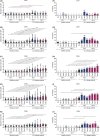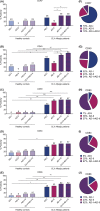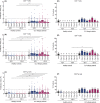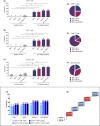Synthetic antigenic determinants of clavulanic acid induce dendritic cell maturation and specific T cell proliferation in patients with immediate hypersensitivity reactions
- PMID: 35611454
- PMCID: PMC9796838
- DOI: 10.1111/all.15383
Synthetic antigenic determinants of clavulanic acid induce dendritic cell maturation and specific T cell proliferation in patients with immediate hypersensitivity reactions
Abstract
Background: Immediate drug hypersensitivity reactions (IDHRs) to clavulanic acid (CLV) have increased in the last decades due to a higher consumption alongside amoxicillin (AX). Due to its chemical instability, diagnostic procedures to evaluate IDHRs to CLV are difficult, and current in vitro assays do not have an optimal sensitivity. The inclusion of the specific metabolites after CLV degradation, which are efficiently recognised by the immune system, could help to improve sensitivity of in vitro tests.
Methods: Recognition by dendritic cells (DCs) of CLV and the synthetic analogues of two of its hypothesised antigenic determinants (ADs) was evaluated by flow cytometry in 27 allergic patients (AP) and healthy controls (HC). Their ability to trigger the proliferation of T cells was also analysed by flow cytometry.
Results: The inclusion of synthetic analogues of CLV ADs, significantly increased the expression of maturation markers on DCs from AP compared to HC. A different recognition pattern could be observed with each AD, and, therefore, the inclusion of both ADs achieves an improved sensitivity. The addition of synthetic ADs analogues increased the proliferative response of CD4+ Th2 compared to the addition of native CLV. The combination of results from both ADs increased the sensitivity of proliferative assays from 19% to 65% with a specificity higher than 90%.
Conclusions: Synthetic ADs from CLV are efficiently recognised by DCs with ability to activate CD4+ Th2 cells from AP. The combination of analogues from both ADs, significantly increased the sensitivity of DC maturation and T-cell proliferation compared to native CLV.
Keywords: antigenic determinants; clavulanic acid; immediate drug hypersensitivity reactions; maturation; proliferation.
© 2022 The Authors. Allergy published by European Academy of Allergy and Clinical Immunology and John Wiley & Sons Ltd.
Conflict of interest statement
The authors declare that they have no conflict of interest.
Figures




References
-
- Torres MJ, Celik GE, Whitaker P, et al. A EAACI drug allergy interest group survey on how European allergy specialists deal with beta‐lactam allergy. Allergy. 2019;74(6):1052‐1062. - PubMed
-
- Salas M, Fernandez‐Santamaria R, Mayorga C, et al. Use of the basophil activation test may reduce the need for drug provocation in amoxicillin‐clavulanic allergy. J Allergy Clin Immunol Pract. 2018;6(3):1010‐1018 e1012. - PubMed
-
- Zambonino MA, Corzo JL, Munoz C, et al. Diagnostic evaluation of hypersensitivity reactions to beta‐lactam antibiotics in a large population of children. Pediatr Allergy Immunol. 2014;25(1):80‐87. - PubMed
-
- Dona I, Blanca‐Lopez N, Torres MJ, et al. Drug hypersensitivity reactions: response patterns, drug involved, and temporal variations in a large series of patients. J Investig Allergol Clin Immunol. 2012;22(5):363‐371. - PubMed
Publication types
MeSH terms
Substances
LinkOut - more resources
Full Text Sources
Medical
Research Materials

